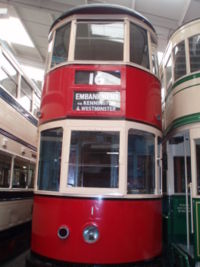London County Council Tramways No. 1 "Bluebird"
 |
It may contain current routes and equipment or historic routes and equipment no longer in service. Reason: Historic London County Council Tramways No. 1 Please feel free to discuss this article on the talk page. |
| This page is under construction. This article is currently undergoing expansion or major revamping. However, you are welcome to assist in its construction by editing it as well. While actively editing, consider adding {{inuse}} to reduce edit conflicts. |
| |
This article is uncategorized. Please categorize this article to list it with similar articles. |

| |
| The Tram in the Exhibition Hall at the National Tramway Museum | |
| Also called | Bluebird |
| Number of decks | 2 |
| Current livery | Red with White Bands around Window |
| Type of trucks | 2 |
| Current Collector | Trolley Pole |
| Numbers | 1 |
| Previous owner | Leeds |
| Current Status | Unrestored |
| {{Infobox UK Tramway}} | |
About
The London County Council Tramways launched number 1 at the Tramways & Light Railways Conference held in London in May 1932. Referring to its original distinctive livery of royal blue and white, it was given the name ‘Bluebird’. It formed part of the efforts by tramway undertakings to fight back against increasing competition from other forms of transport. Globally, the best-known resulting vehicle was the PCC car in the USA. In Britain there were the ‘Felthams’ of the Metropolitan Electric Tramways and LUT, new Blackpool trams and the Liverpool streamliners among others.
‘Bluebird’ was a double-ended bogie car, incorporating many improvements over earlier LCC cars. After the Conference, the car went into public service from Holloway depot, working ‘subway’ services 33 and 35. It left London in 1951 and saw further service in Leeds. After returning from Leeds, number 1 went to the Museum of British Transport, Clapham. Later, it was presented to the Tramway Museum Society for preservation and eventual restoration, becoming the first (and for many years the only) London tramcar at the N.T.M. at Crich. Apart from some alterations made in Leeds, all of which can be reversed, ‘Bluebird’ is still in substantially original condition; even the original blue livery can be seen under subsequent paint layers. It is now seen as having greater historical significance than its isolated existence in London might suggest, being when new equal to, or better than, the most up-to-date motor bus in both technology and passenger comfort

